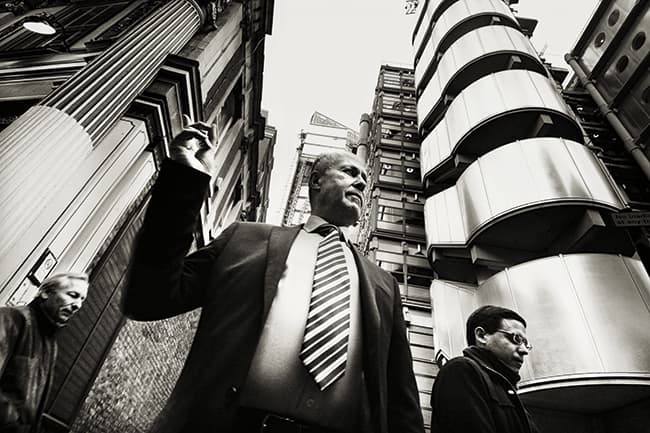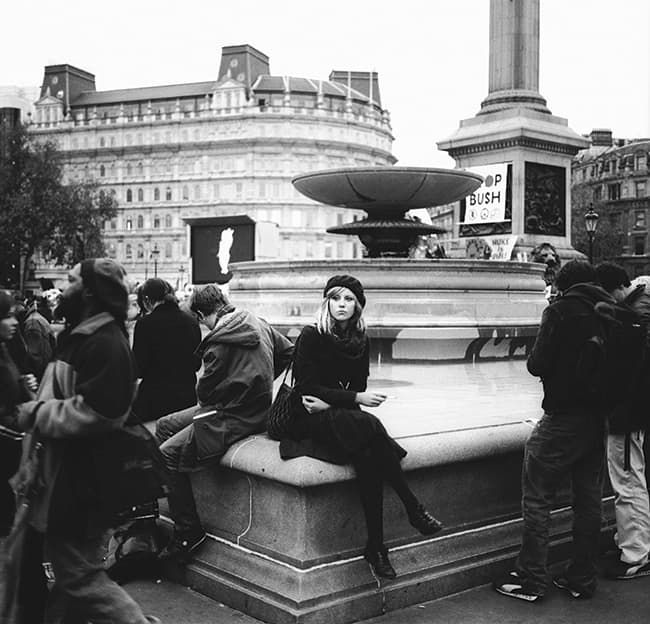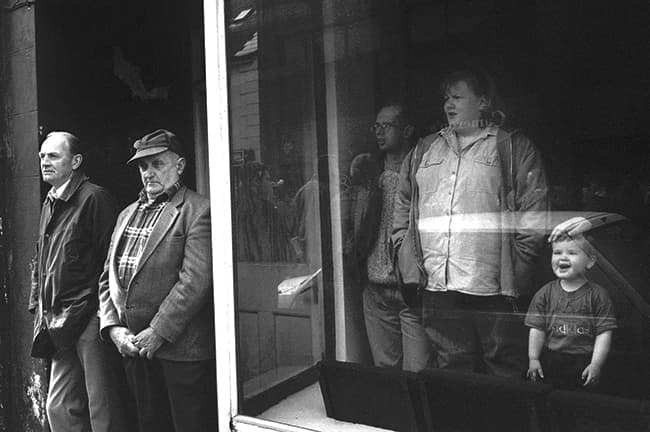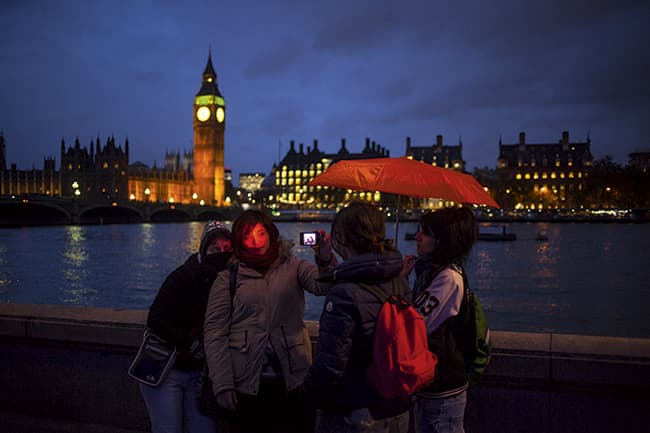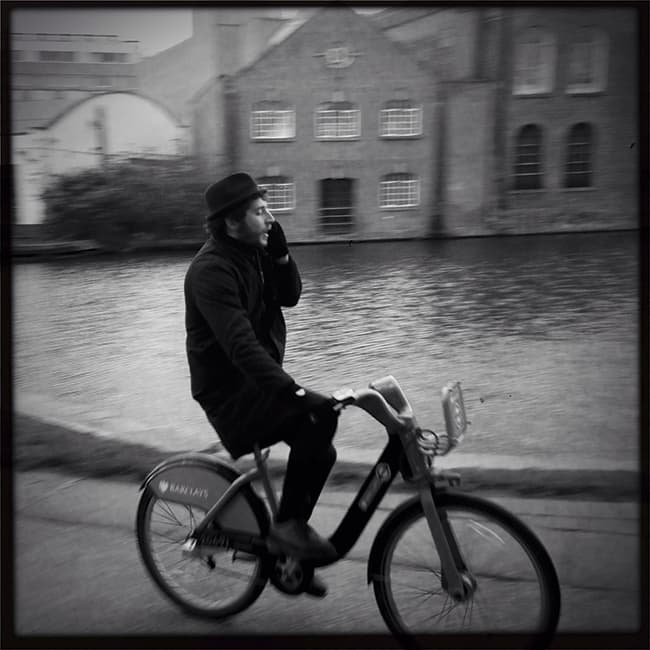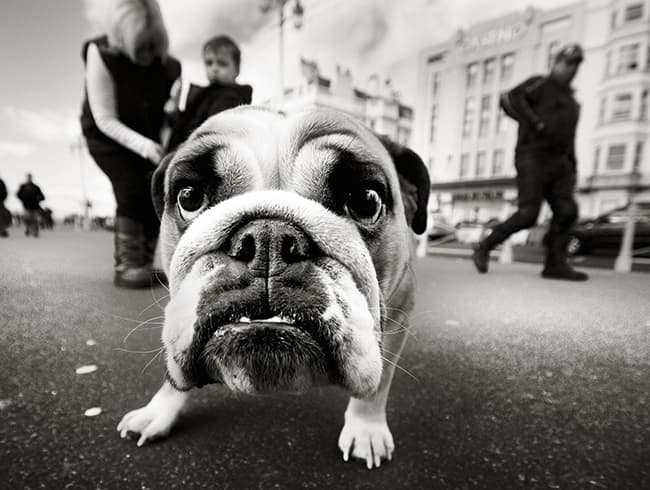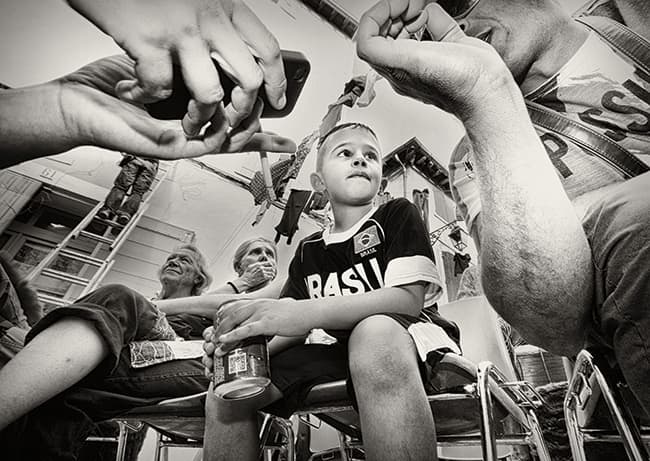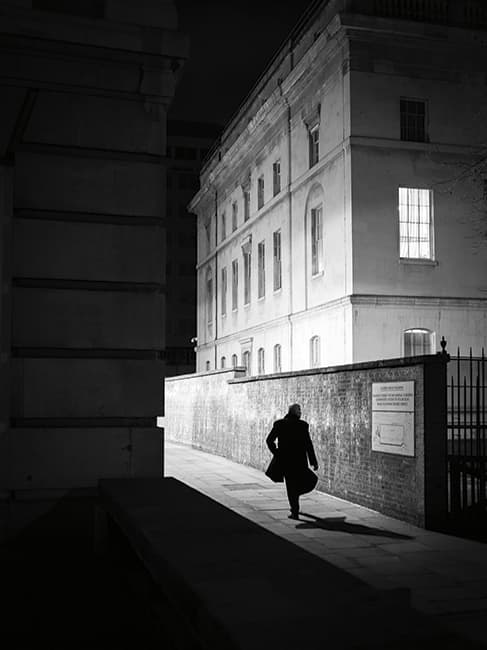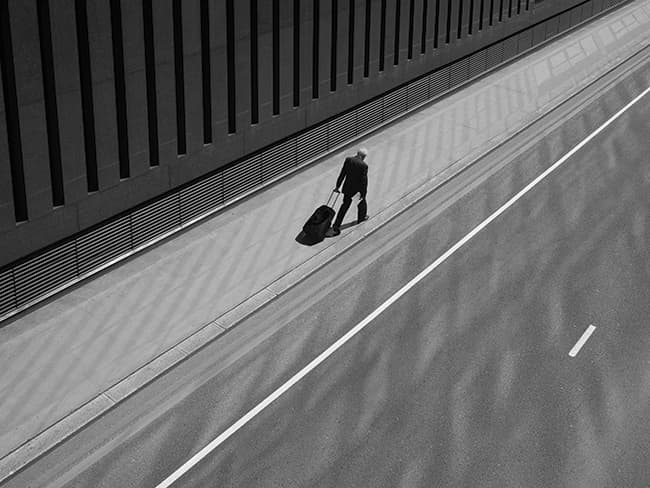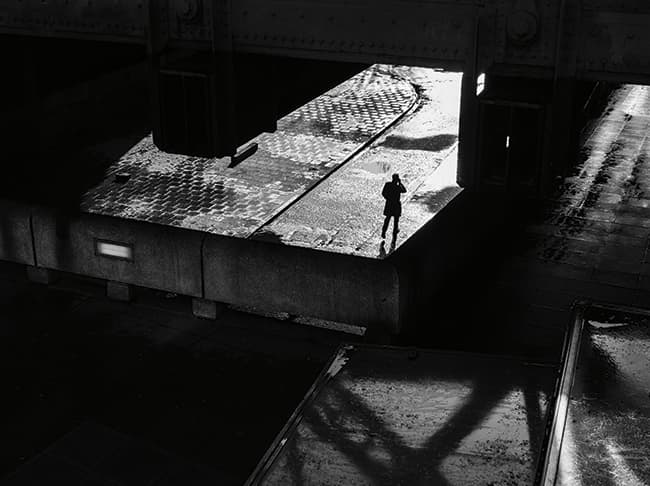Three top photographers share their expert tips and insights on how to get the best street photography shots. Read below for the top 10 commandments of street photography:
10 Commandments of Street Photography
Commandments of Street Photography from Antonio Olmos

Antonio Zazueta Olmos is a Mexican photojournalist who has worked extensively in the Americas, the Middle East and Africa covering issues of human rights, conflict and the environment. He is a regular contributor to The Guardian and The Observer, and his first book, The Landscape of Murder, was published by Dewi Lewis in 2013. Visit his website at: www.antonioolmos.com
1. Most of your photographs will suck
I always say that taking photographs is like taking notes – you take a lot of them in the hope you will make one that’s amazing. A lot of people new to photography are disappointed by how many bad pictures they take.
Well here is a little secret: everyone, even pros, take lots of bad images. Like a writer with piles of notes, the photographer must learn to edit his or her work and sift through a stack of pictures to look for that one strong image. I go out into the streets hoping to make one good photograph. Most of my images are a disappointment. Sometimes I try things and they just don’t work.
Photography for me is about learning to live with constant disappointment. If photography was easy, every image we take would be brilliant. Photography is hard because that great image is very difficult to get.
When you do street photography you are working in an environment that you have no control over. People will get in your way, the image will be gone before you raise your camera to your eye, the light will change or you will get the focus wrong. A million things will not work when trying to take an image.
A great image from street photography comes from perseverance, patience and complete focus on the task at hand.
2. Wear comfortable clothing
First, make sure you have a good pair of shoes. If you’re serious about street photography you’ll be on your feet all-day long, searching for that elusive image.
Many of my favourite shots have come after hours of walking. People with bad shoes tend to give up much sooner than those who are wearing comfortable shoes. It’s not just the shoes, though, as you should wear comfortable clothing that reflects the weather you are working in. Cheap shoes lead to blisters – I guarantee you Henri Cartier-Bresson had good shoes.
Don’t carry too much gear, either – try to work with one camera and a couple of lenses. If you are comfortable and not weighed down by your kit, you will have a productive day.
You should also drink lots of water and take breaks, but when you take those breaks get a table on the pavement or sit near a window. You never know what will walk by while you are sipping your latte.
3. Use short lenses
In my opinion, truly great street photography is shot on 50mm, 35mm, 28mm or 24mm lenses. The 35mm is my favourite, whether it’s fitted to my Leica, Sony or my Canon. In fact, I wish I had a zoom that went from 35mm to 50mm and nothing more, but those pesky lens manufacturers just won’t listen to me.
Zooms for the most part are not good for street photography. You need to think and see like the lens on your camera. If you shoot with just one lens you will learn how the image will look. Short fixed-focal lenses also force you to get close to the subject. And that immediacy is what makes great street photography. You feel like the photographer is right in the midst of the action. Our Prime vs Zoom lenses – which is best? article reveals the pros and cons for both.
Zooms make you lazy. You stand around and zoom in on the world instead of getting in the thick of it. Zooms are also heavier and bigger than your average fixed-focal-length wideangle or normal lens. They make your camera stand out, so you’re more likely to get noticed when you’re trying to be discreet.
Zooms are heavier and your neck and shoulders will suffer, while fixed-focal-length lenses are lighter and smaller, which is essential in street photography. Fore more, see the best lenses for street photography.
4. You have to like human beings
If you don’t like people and think most of them are complete idiots, then I suggest you steer well clear of street photography. I find human beings endlessly interesting.
I love the way they move, I love their faces, I love the way they dress, I love how they interact with the urban environment – in fact, I love everything about them. It’s a joy taking their pictures, and I truly believe people can see that about me. They also read my body language and get a sense that I am no threat to them.
If you walk around taking photos in the street, constantly worried about getting mugged or questioned about what you are doing, you are going to give others the sense that you are not comfortable.
Commandments of Street Photography from Jerry Webb
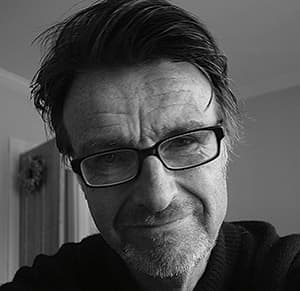
Jerry worked in publishing as a designer, followed by a number of years as an art editor with EMAP. In 1988, he turned freelance and has remained so ever since. Despite moonlighting as a photographer during his publishing days, Jerry took up photography for himself in 2007 after buying a Nikon D80. He shoots mainly in monochrome around Brighton and Hove. Visit his website at: www.jerrywebbphotography.com
5. Proximity
How close you are to your subject can be significant. Good street work requires a reasonable wideangle lens and using one usually demands that you are fairly close. The closer you are, the more involved with the subject you become and the more involved the viewer will feel when looking at your photographs.
I use a 12-24mm lens, usually around the 12mm mark, meaning I tend to work pretty close a lot of the time. Experience tells me what will appear on the image without making myself conspicuous by looking through the viewfinder. Adjusting the camera settings is another way of making yourself conspicuous, so set them before you begin taking photographs and leave them. With confidence comes a willingness to get in closer and perhaps even to use fill-in flash.
Working closely does not necessarily prevent you from shooting candids, which can be shot with the full knowledge of the subject.
Although contact does not constitute pure street photography for many, interaction does not prevent you getting strong images. Sometimes you have no choice, so don’t be afraid to ask. Talking with your subject can provide you with valuable time to think about what you want and the opportunity to direct.
Some of my best pictures are of people who have consented to be photographed, but they are taken just before they think the session has started or just after they think it has finished. I then capture completely natural moments – often from positions too close for true candid photography.
6. Working with different planes
Many of the best street photographs have both foreground and background interest – one can feed off the other. Success in achieving this requires patience and sharp intuition, but it can give a powerful dynamic to your photograph. If the foreground relates to the background this can help to create a good narrative, or perhaps a great juxtaposition. Either way, leading the viewer’s eye around the photo adds depth and interest.
Although snatching images on the street that work like this involves good instinct and a degree of luck, you can improve your ‘luck’ with some foresight and planning. On a simple level, find an interesting background – this can be anything from a poster to a shop front, bold typography or a group of people – and just wait for something to happen. This is the patience bit. Experience will tell you what works best.
I find that having something in mind often helps, but also try keeping your options open for something more spontaneous, as many of my favourite pictures are catching the unexpected. Occasionally you get lucky and find an accidental, but witty, connection between the foreground and background during processing. Sometimes there needs to be no connection at all; simply having movement or interaction on two planes (or even three) of the picture can make a striking photograph.
Close proximity to crowds or being in a group creates natural foreground and background interest if you are using a wide lens. This has a deeper depth of field, making focusing easier. Purists may object to the natural distortion of the lens, but it can add drama and tension.
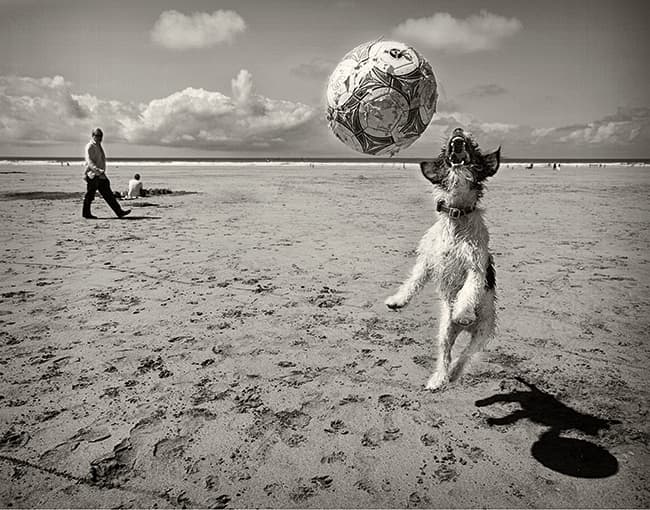
Simply having movement or interaction on two planes (or even three) can help to create a striking photograph, Jerry Webb
7. Choosing your environment
Being a street photographer or just taking candid pictures can be stressful at times and difficult to conceal. So the environment you choose to work in plays a major part, whatever your experience may be and however good your technique.
Selecting where you photograph is absolutely key in street photography. Location can not only dictate the style of pictures and how you go about creating them. But it also affects how you and those you are photographing are feeling.
Choosing your local area gives you a number of advantages. It gives you the benefit of local knowledge, a feel for where to look for pictures and an understanding of the people. Plus maybe a little added confidence. Investigating new locations can bring added excitement and inspire new ideas. But returning to the same location and using both your experience and knowledge of the location can pay great photographic dividends.
As a general rule, the busier the environment the easier photography can be and the more picture opportunities there are available. After a while you develop an instinct for whether the location will be fruitful or not. Public or sporting events, or tourist areas, are ideal for people photography and particularly suited to the novice or those lacking confidence. You will usually find a greater acceptance and a relaxed attitude to photographers, and often such places are full of other people taking pictures. This makes it so much easier to blend in and provide you with a more relaxed photography experience.
One of my most successful (and lazy) techniques is to find a seat in a busy street or shopping area and just sit there with a camera. I let the subjects come to me and wait for groups of people, movement, unusual dress or just interesting interaction. Often buying myself an ice cream or a drink while waiting. Looking relaxed while taking photographs in public helps to avoid attention. Nervous photographers are always more visible. If you find a good location, be patient and take plenty of shots as it may be a while before you find something better.
Commandments of Street Photography from Rupert Vandervell

Born and based in London, Rupert’s photographic style is highly representative of his personality. He’s always been obsessed with clean lines and the geometrical appearance of things.Through the lens he finds people captivating and his work explores our relationship with the world and how we interact with our environment. Visit his website at: www.rupertvandervell.co.uk
8. Shoot at night
I love to shoot at night, especially during the winter months when good daylight is scarce and it starts to get dark around 5pm. I will sometimes spend hours on the streets at night. If I’m shooting for a specific project, I will have in mind a place that I hope will provide the right kind of scene and then work in and around it.
The one great thing about night photography is that the light is always the same and it doesn’t matter what the weather’s doing. In fact, if it’s wet you’ll have much more to play with in terms of atmosphere. Places look very different under the streetlamps and an area you might not have considered for street work may suddenly become a good hunting ground.
I treat night shoots in the same way as I do day shoots, and to make it work you need at least one good light source. I try to choose areas that have at least one main streetlamp, which will hopefully define the area where I want to work. From there I find the best viewpoint to balance the scene regarding light, shadow and subject.
Additional lighting can come from car lights, reflections and shop windows. I’m never too bothered about getting a technically perfect shot at night. What I am looking for is the right atmosphere.
You will be shooting with a higher ISO and a certain amount of grain is inevitable, which is often what helps to make the shot more authentic. People in the city become more isolated at night as there are fewer of them around and the mood is completely different to during the day. I’ve always been fascinated by the film noir look – those wonderful figures in hats and overcoats emerging from deep shadows at night always inspire me.
9. Use a small camera and carry only the essentials
When I go out to shoot, I want to feel like I’m one of the crowd, and blend in and remain anonymous. The last thing I want to do is to draw attention to myself. I see guys lugging bulky and heavy-looking cameras and gear around with them and wonder how they manage.
For street photography, carrying too much gear around with you is a mistake. It’s tiring and restricts your movements. I can be out for hours at a time and I may get tired from constantly being on my feet, but never from carrying a heavy camera bag.
A smaller camera is easier to conceal and you won’t be advertising what you’re up to. Between shots you can hide it under your jacket or behind you as you move into position. Sometimes it’s all about stealth. I remember seeing Joel Meyerowitz shooting on the streets of New York. He moved like a cat. You wouldn’t know what he was up to until it was too late and he’d got the picture.
There are so many great small and lightweight cameras around. I use an Olympus OM-D E-M5 with a 20mm lens. It’s fast, small and very light. I prefer to use my feet to do the framing and get myself into the right position for the shot. Street shooting is about being in the right place. If you are more mobile, you’ll give yourself a better chance.
For more options don’t miss our Best Camera for Street Photography roundup.
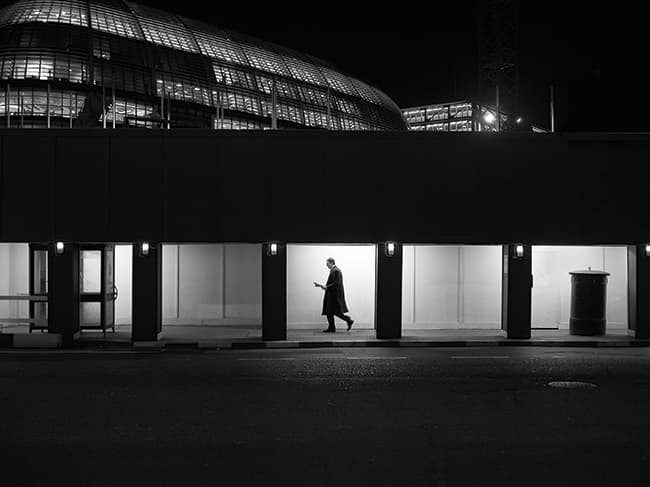
Between shots you can hide your camera under your jacket or in a pocket as you move into position, Rupert Vandervell
10. Be patient
You may find a place that you think will be the perfect setting for a shot, but something isn’t quite as you want it. The light may not be right or perhaps people haven’t yet walked into the frame. Some photographers are too ready to move on if they don’t immediately see something to their liking.
It’s not just about looking at what’s in front of you, as you have to look right into a scene to see its potential. A slight movement to the left or right, or moving in closer, can reveal a whole new dimension to a shot.
I will always stay with an area if I think it might yield something. I get more excited by the minute at the prospect of capturing just what I have in mind and love watching how the light plays with a scene. I’ve learned to be very patient and I won’t leave until I think I’ve got the best I can. The light can change very quickly depending on the time of year. I have watched shadows sliding into new positions to create a completely different feel.
When shooting people, I try to anticipate their movements and how they might feature. You need to be ready and poised for that moment when they hit the right spot.
If you’re lucky and you’ve combined the perfect light with everything else, then you’ll feel happy that you waited around to get it. Good shots come to those who wait.
New to street photography? Check out our complete guide to Street Photography. Remember to stay street smart.
See the best cameras for street photography here.
Read more:
Street photography and the law
Using smartphones for street photography
How the pandemic changed street photography
Black and white street photography guide

